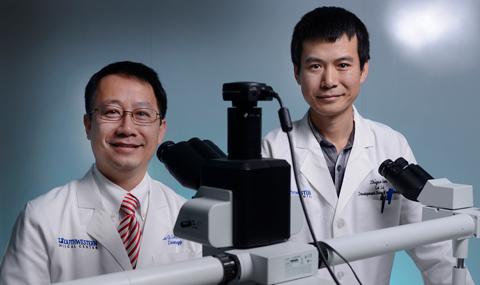Study identifying cell of origin for large, disfiguring nerve tumors lays groundwork for development

Using this multihead microscope to study large, disfiguring tumors called plexiform neurofibromas, UT Southwestern's Dr. Lu Le, left, and postdoctoral researcher Dr. Zhiguo Chen determined the cell of origin for these tumors, a finding that may assist in developing new therapies. Credit: UT Southwestern
“This advance provides new insight into the steps that lead to tumor development and suggests ways to develop therapies to prevent neurofibroma formation where none exist today,” said Dr. Lu Le, Assistant Professor of Dermatology at UT Southwestern and senior author of the study, published online and in Cancer Cell.
Plexiform neurofibromas, which are complex tumors that form around nerves, occur in patients with a genetic disorder called neurofibromatosis type 1 (NF1), which affects 1 in 3,500 people. About 30 percent of NF1 patients develop this type of tumor, which is typically benign.
NF1 patients with plexiform neurofibromas, however, have a 10 percent lifetime risk of the tumors developing into malignant peripheral nerve sheath tumors (MPNSTs), a deadly, incurable type of soft-tissue cancer. In addition, due to their unusual capacity for growth, plexiform neurofibromas can be life-threatening by their physical impairment of vital organs or neural function.
While there are no currently approved therapies for either MPNSTs or plexiform neurofibromas, Dr. Le said determining the cell type and location from which these tumors originate is an important step toward discovering new drugs that inhibit tumor development.
“If we can isolate and grow the cells of origin for neurofibromas, then we can reconstruct the biological steps that lead these original cells to tumor stage,” said Dr. Le, a member of the Harold C. Simmons Cancer Center. “Once we know the critical steps in the process, then we can design inhibitors to block each step in an effort to prevent or slow tumor formation.”
Using a process called genetic labeling for cell fate tracing, researchers determined that plexiform neurofibromas originate from Schwann cell precursors in embryonic nerve roots.
“This study addresses a fundamental question in the neurofibromatosis field,” Dr. Le said. “It points to the importance of stem cells and their immediate progenitors in the initiation of tumors, consistent with the notion that these neoplasms originate in a subset of primitive precursors and that most cells in an organ do not generate tumors.”
In a related study published last year, Dr. Le's research team found that inhibiting the action of a protein called BRD4 caused tumors to shrink in a mouse model of MPNST. UT Southwestern is working with a pharmaceutical company to bring a BRD4-inhibiting drug into clinical trials for MPNST patients.
New drugs are desperately needed to treat both MPNST and plexiform neurofibromas, said Dr. Le, who also serves as co-director of UT Southwestern's Comprehensive Neurofibromatosis Clinic. The clinic, co-directed by Dr. Laura Klesse, Assistant Professor of Pediatrics and a Dedman Family Scholar in Clinical Care, is part of the Harold C. Simmons Cancer Center and serves patients with all types of hereditary neurofibromatosis.
Other UT Southwestern researchers involved in the Cancer Cell study, all in Dermatology, were first author and postdoctoral researcher Dr. Zhiguo Chen; postdoctoral researchers Drs. Amish Patel and Chung-Ping Liao; and research associate Yong Wang.
The study was funded by UT Southwestern's Disease-Oriented Clinical Scholars Program, the Elisabeth Reed Wagner Fund for Research and Clinical Care in Neurofibromatosis and Cardiothoracic Surgery, the National Cancer Institute, the Children's Tumor Foundation, and the U.S. Department of Defense.
UT Southwestern's Harold C. Simmons Cancer Center is the only National Cancer Institute-designated cancer center in North Texas and one of just 66 NCI-designated cancer centers in the nation. The Harold C. Simmons Cancer Center includes 13 major cancer care programs with a focus on treating the whole patient with innovative treatments, while fostering groundbreaking basic research that has the potential to improve patient care and prevention of cancer worldwide. In addition, the Center's education and training programs support and develop the next generation of cancer researchers and clinicians.
About UT Southwestern Medical Center
UT Southwestern, one of the premier academic medical centers in the nation, integrates pioneering biomedical research with exceptional clinical care and education. The institution's faculty includes many distinguished members, including six who have been awarded Nobel Prizes since 1985. Numbering approximately 2,800, the faculty is responsible for groundbreaking medical advances and is committed to translating science-driven research quickly to new clinical treatments. UT Southwestern physicians provide medical care in 40 specialties to about 92,000 hospitalized patients and oversee approximately 2.1 million outpatient visits a year.
Media Contact
More Information:
http://www.utsouthwestern.edu/All latest news from the category: Life Sciences and Chemistry
Articles and reports from the Life Sciences and chemistry area deal with applied and basic research into modern biology, chemistry and human medicine.
Valuable information can be found on a range of life sciences fields including bacteriology, biochemistry, bionics, bioinformatics, biophysics, biotechnology, genetics, geobotany, human biology, marine biology, microbiology, molecular biology, cellular biology, zoology, bioinorganic chemistry, microchemistry and environmental chemistry.
Newest articles

Superradiant atoms could push the boundaries of how precisely time can be measured
Superradiant atoms can help us measure time more precisely than ever. In a new study, researchers from the University of Copenhagen present a new method for measuring the time interval,…

Ion thermoelectric conversion devices for near room temperature
The electrode sheet of the thermoelectric device consists of ionic hydrogel, which is sandwiched between the electrodes to form, and the Prussian blue on the electrode undergoes a redox reaction…

Zap Energy achieves 37-million-degree temperatures in a compact device
New publication reports record electron temperatures for a small-scale, sheared-flow-stabilized Z-pinch fusion device. In the nine decades since humans first produced fusion reactions, only a few fusion technologies have demonstrated…





















